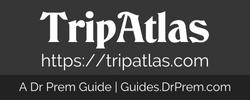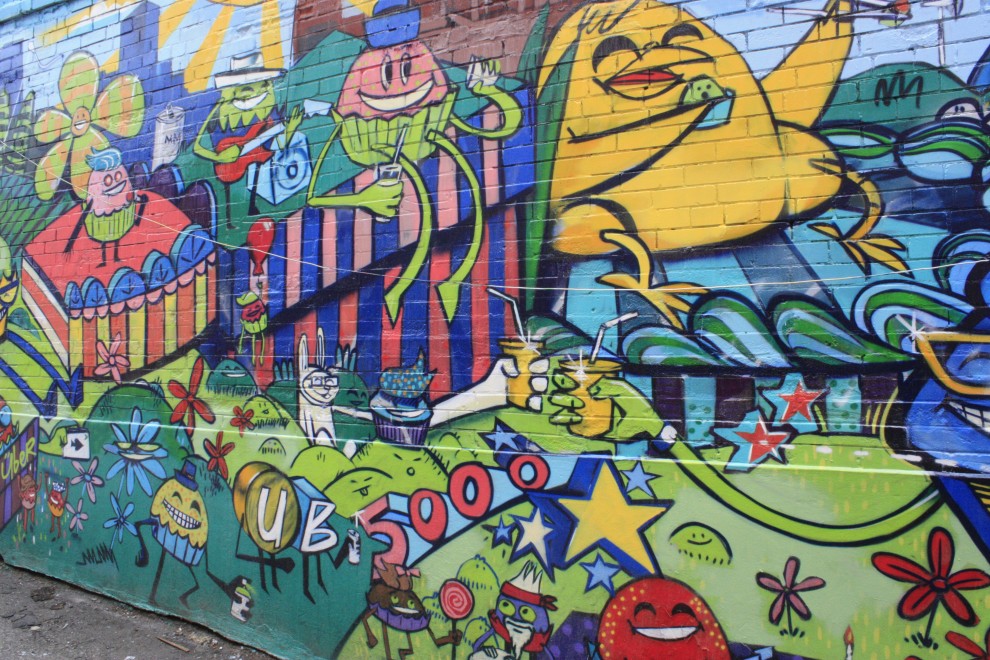Kensington Market could be called point zero when it comes to multiculturalism in Toronto. Jewish, Portuguese, Hungarian, Vietnamese, Caribbean, South Americans and University of Toronto students are among the many groups who have made this downtown neighborhood, next to Chinatown and the Art Gallery of Ontario, their starting point.
Each culture left their mark and the result is an eclectic bustling bazaar packed with restaurants, cafes and merchants selling everything from international food and spices to clothing.
The district is not a big one, spanning about five blocks in either direction, but what it lacks in size, it more than makes up for in character. Jason Kucherawy, who leads pedestrian tours with Intrepid Travel’s Urban Adventures, says he “likes to take people into the nooks and crannies of the market.” We find out why when after being led through a narrow alley, we’re surrounded by colorful graffiti murals. Jason points out the signature features of this artist’s piece. A ‘piece’, we find out, is graffiti lingo for more intricate work, differing it from a throw-up or a tag. There are many impressive ‘pieces’ in Kensington Market, reflecting its hip culture.
It’s also a National Historic Site and we visit some of its more notable landmarks including the architecturally distinct Kiever Synagogue, and a statue of Al Waxman, a TV star made famous by his role as a market vendor in the King of Kensington, a Canadian TV show by the same name (he’s also known for his part as the lieutenant in the 1980s police drama Cagney and Lacey).
Just as easily as our tour guide can identity a graffiti mural artist, he can recite the area’s history. At the beginning of the 20th century, Jewish merchants, excluded from the main business community, moved into the neighborhood and began selling goods, initially from handcarts pushed through the streets, then stalls and stores, often on the ground floor of the owner’s house. By the 1920s, approximately 80% of Toronto’s Jewish population lived in the area, worshipping at over 30 local synagogues.
In the 1950s, the community started to move into outlying areas and post-war immigrants moved in. As each group grew more affluent and moved on, others moved in, adding layers to an ever-changing market district, creating the vibrant and eccentric atmosphere that exists today.
And the two best ways to experience this –and the two reasons most Torontonians frequent this neighborhood– is to eat and to shop. You won’t find any big chains; residents are fiercely loyal to their local establishments and have refused to patronize any that have attempted to move in.
In addition to food stalls, clothing is a big draw. Courage My Love, a Kensington fixture since 1975, is a hippie-flavored clothing store with a loyal following, which flock here for cheap vintage clothes, exotic jewelry, scarves, kitsch home accessories and trinkets of all sorts. Next door is Exile, also well known for its vintage clothes collection. Its busiest time is Halloween as partygoers transform into Mad Men, Lady Gaga, Burlesque showgirls and vampires. The rest of the year brings in people looking for something different, whether it’s used denim and 80s iron-on transfers or vintage cocktail dresses and prom wear. Blue Banana Market, sells on consignment from numerous vendors so you’ll find handcrafted jewelry next to houseware products, and artwork sharing space with imported toys and candy.
Once you’ve worked up an appetite, it’s on to the next popular past time – eating. At Big Fat Burrito, located next to a tattoo parlor, students and professionals sit elbow to elbow to savor spicy steak burritos and nachos. Jumbo Empanadas is where you’ll find Toronto’s version of Chilean street food. You’ll find traditional styles of empanadas (stuffed baked or fried pastries) like cheese, beef, vegetable and chicken, but also more exotic versions like kimchi (Korean pickled cabbage) empanadas and corn pies (pastel de choclo). More upmarket, is Torito Tapas Bar, modeled after Barcelona tapas bars. This intimate yet lively restaurant serves up snack-sized Spanish dishes, like tortillas, crab croquettes, shrimp ajillo (garlic) and braised beef tongue and cheeks. And for something completely different, there’s Hungary Thai, which is, as their name suggests, a mix of Hungarian and Thai cuisine. Combo plates with spring rolls, cabbage rolls, chicken pad thai and wiener schnitzels are available. This mix would be extremely odd in any other place, but here in Kensington Market, where a mix of cultural influences is the norm, it somehow fits right in.
If You Go:The district’s approximate borders are College Street to the north, Dundas St. W. to the South Spadina Ave. to the east, and Bellevue Ave. to the west.
Intrepid Travel’s Urban Adventures: Kensington Market and Chinatown Walking Tours can be booked online at www.urbanadventures.com. For information on other tours visit www.tourguys.ca
Find more information about Kensington Market along with 65 more free things to do, 200 other attractions and 1400 photos in the Toronto Essential Guide iphone app.- Featuring google maps, offline content, free updates and insider information that goes beyond the generic blurbs or unfiltered lists of free apps, it’s the only guide you’ll need on your visit to Toronto. http://sutromedia.com/apps/Toronto_Essential_Guide


